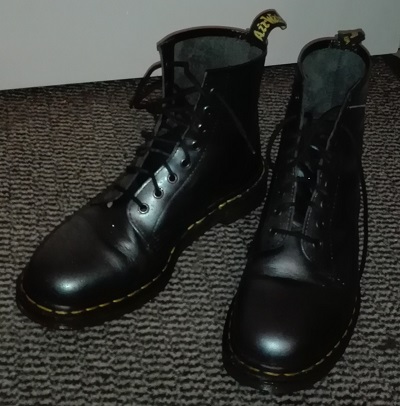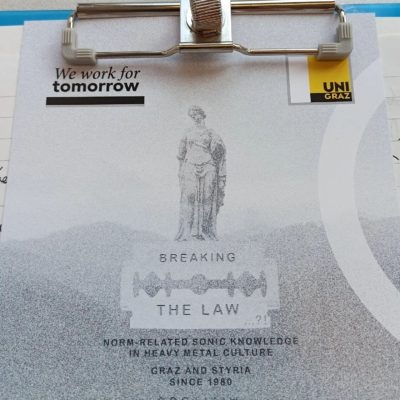Widely known, Dr. Martens boots (usually refered to as ‘Doc Martens’, ‘Docs’ or ‘Dr. Martens’) are one of the established fashion codes of several different subcultures. Being initially worn in Mod- and Skinhead-subcultures from the 1960s onwards, they were soon worn by Punks, ‘Goths’, and members of the EBM-, Wave- and Dark-Wave-scenes, too. Until today, they also are an established code in Metal culture. Being introduced to subcultural discourses in the 1960s, they until today bear with them an ‘aura’ of protest, proletarian spirit, of noncomformist identities. Given that today they are part of a huge branding and marketing discourse, whose final very conservative purpose is to earn money, it is somehow surprising that this code still ‘works’.
The boots were invented by German medical doctor Klaus Märtens shortly after World War II.1 In 1945, he injured his ankle and was looking for solid yet comfortable boots when recovering from his injury. He designed a boot using soft leather and air-padded soles made of tires. The new footwear was not an instant success; but in 1947, when meeting his university friend Herbert Funck, who was impressed by Märtens’ invention, things changed. In 1952, they opened a factory in Munich. In 1959, the boots became marketed internationally, and British company R. Griggs Group Ltd. bought patent rights to manufacture the boots in the United Kingdom, where they were sold for the first time in 1960.
The company introduced the until today common name, slightly re-shaped the heel and, most of all, added the trademark yellow stitching. Also, in this first process of branding the soles were branded as ‘AirWair’ soles. Soon, the new shoewear was worn by police officers, postmen and factory workers. By the late 1960s, they were used as a cultural-material code in the early Skinhead-scene. In the 1970s and 1980s, as mentioned, they became part of the Punk-, ‘Goth’-, Wave- and Dark-Wave-Scenes, too. Also members of EBM-groups and Metalheads wore and wear their Docs.
Being a rather late starter, I decided to buy my first Docs this year (being 37 years old, this maybe is one of the first symptoms of a Metalhead’s midlife crisis). Buying these boots made me remember their history; as a cultural historian interested in Metal Music Studies, I am interested in how this shoewear managed to become a ‘working’ code in so many different cultural discourses over five decades. They were common when I was teenager, and still in in my twens. Today, they seem to experience a certain revival. But, most of all, as a historian in Metal Music studies, I want to ask what these shoes can tell us about writing the history of Metal culture – in the context of a broader historiography of subcultures since the 1960s.
In this context, the mentioned ‘omnipotent’ subcultural capital of the Dr. Martens boots seems to be their most important historical feature. They ‘work’ in at least seven different subcultures: Skinheads, Punks, ‘Goths’, Wavers and New Wavers, EBM-Fans and Metalheads wear their Doc Martens. So, their cultural main feature is that they are a ‘trans-scene-ary’ code of shoewear. They construct these different identities and, at the same time, the transgress the boundaries between the scenes.
What could a cultural historian of Metal music learn from this? I suppose, we can discover two major aspects: first, the history of material artefacts, such as shoes, is a very good way to tell Metal history. Secondly, when writing this history, we have to be aware of these ‘trans-scene-ary’ features of cultural codes. They are liquid, form varying and oscillating circles of negation and the construction of identities. To tell the history of Metal culture, means to deal with material items that bear in them very heterotopic semiotic structures. We do not have to essentialize these codes but to see them as objects of constant definition and re-definition.
For their history, cf. Martin Roach, Dr. Martens. The Story of an Icon. London: Chrysalis Impact, 2003. ↩



